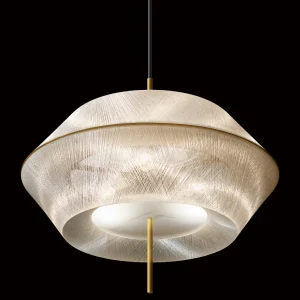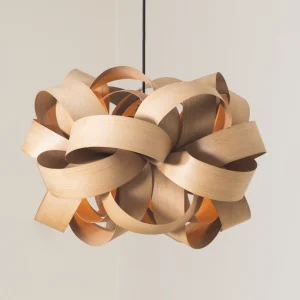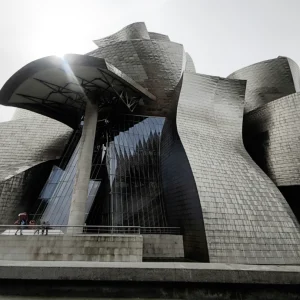Can you pinpoint the thought, whether yours or someone else’s, that led you to a career in design?
As far back as I can remember, I have always been obsessed with drawing. I distinctly remember primary one at school and being frustrated because the things I drew didn’t look enough like the things I saw. Saying that, the teachers seemed impressed. But maybe Mrs Falsy was just being nice!
I was only interested in art at school, so much so that the deputy head of my high school took me aside one day and asked, ‘What are you going to do for a job if you fail at art?’ It was only later in life that I realised just how lucky I was to have such a great and supportive art department, particularly Ms Jardine. She was first to plant the seed, suggesting ‘Your style is quite graphical – have you considered graphic design?’
I didn’t get accepted to the graphic design course I applied for, and I had no back-up plan. My best buddy, who I grew up drawing comics with, had been accepted to an ‘interior design’ course – whatever that was. He said I should meet the big cheese that ran the course. I did and she offered me a spot.
Fast-forward almost 30 years…
In terms of the design and architecture industry, what do you consider the most radical era or pivotal moment?
I think it’s much easier to assess radical eras or significant change in hindsight – although we’ll inevitably always have some ‘prophets’ pop up claiming they predicted them all along. In reality, each era explores its own ideas of what architecture and design is, building upon (or rejecting) what previous generations have done, and change can often be slow and incremental. The Industrial Revolution and mass production has arguably had the biggest impact on modern construction and the planet – not all of which are positive.
 A book that has inspired Hughes’s thinking
A book that has inspired Hughes’s thinking
Which radical thinkers have been inspirations to you in your career?
For me, appreciation of radical thinking didn’t happen until I was settling into my career. Like many young creative thinkers, I probably had (too much?) self-belief and confidence in exploring my own lines of inquiry. In hindsight, I don’t think this is a negative thing. It meant I formed the foundations for my own philosophy (if you can call it that) or approach to design without trying to emulate others. It’s only later when I did start appreciating design theory by others that I realised some were parallel to my thinking, with many being explored long before I came to the table.
My list of inspirations grows daily but rarely is it anyone directly in my profession. I seek out and soak up any form of creative thinking and expression. Dieter Rams’ Ten Principles for Good Design (circa. 1970s) is as good a place to start as any, for any creative professional – just swap out the word ‘product’ for your specific area, e.g. architecture, interiors etc.
Who are the radical thinkers who inspire you now? (Not necessarily forever or for a lifetime – just now!)
In no particular order: Jessica Brillhart (specialising in exploring the technology and language of the mediums of virtual reality, augmented reality, and intelligent systems), Manoush Zomorodi (journalist, podcast host and author), Lucy Easthope (expert and adviser on emergency planning and disaster recovery), Thomas Demand (artist), Charlie Porter (journalist), Claire Dederer (writer, author), Kathleen Jamie (poet, writer), Jenn Nkiru (director).
I’ve been down a bit of a rabbit hole in recent years, exploring and attempting to understand how to enable maximum creativity and ways of approaching challenges – the ideal end result being better design for people. The people above have inspired this exploration in a variety of ways.
 He stills scribbles if he finds himself in a boring meeting
He stills scribbles if he finds himself in a boring meeting
Who outside the industry can architects and designers learn from?
An article in Wired magazine a few years back really resonated with me. It talked about diversity as a ‘super power’ – it said to ‘fill yourself with ideas from elsewhere and surround yourself with people from elsewhere; the weirder (to you) the better’. It also talked about ‘crowdsourcing knowledge’, and highlighted the (now obvious) fact that ‘you were probably taught most things you know by an individual person’, but that does not necessarily mean you were taught the best technique.
I repeatedly nag our teams to be a sponge, soak up everything around you, even bad design – we must acknowledge it and understand it as much as good design, if we are ever to avoid making the same mistakes.
What will lead the way for more radical thinking in your/our field?
We must explore and immerse all our senses beyond our own echo chambers. We should know when to quit navel gazing and get out there, speak to people, experience things firsthand. Architecture and design is always on the cusp of being elitist and unapproachable or unobtainable to many, but I believe good design should be for everyone. Good doesn’t necessarily mean expensive.
I’m convinced there’s an abundance of untapped knowledge and ideas out there that could radically change how we make design and architecture more inclusive, sustainable and obtainable to all. Ideas could come from people with less baggage and stakes in our current design and construction models.
 Hughes thinks best with a cup of coffee, music, and some scraps of paper and a pen
Hughes thinks best with a cup of coffee, music, and some scraps of paper and a pen
Could you recommend a book/article/blog that inspired your thinking?
Beyond the usual suspects (TED talks, World Economic Forum etc.) I discovered a few great books through another source of inspiration.
For the life of me, I can’t remember who recommended them (sorry if it was you!). One of them is The Universal Traveller by Don Koberg and Jim Bagnall, a ‘soft-systems guide to creativity, problem-solving and the process of reaching goals’. Shikake – The Japanese Art of Shaping Behavior through Design by Naohiro Matsumaru has some great ideas, and for pure visual joy and inspiration Ronan Bouroullec’s recent reference book Day After Day.
Could you name two buildings/pieces of furniture that you consider radical designs of their time, or perhaps still to this day?
Dieter Rams’ 606 Universal Shelving System for Vitsoe, 1960 – perhaps not the first modular system, but absolutely one of the best, which has (unsurprisingly) stood the test of time, adhering to all of Rams’ Ten Principles of Good Design.
Instead of a single building, an entire (series of) islands; Naoshima in Japan being the main event. A truly visionary collaboration between the mayor, a businessman and an architect – Tadao Ando no less. The aim being to unify art, architecture and nature, while offering an alternative to the primarily urban museum experience.
I think best with… (e.g. my hands/a pencil/ with a computer)
A cup of coffee to-hand, music playing with ideally no other audible distractions. A comfortable set-up (discomfort = distraction) with some scraps of paper and a pen.
I think best… (e.g. first thing in the morning/ last thing at night)
Consciously, I think best throughout the day in quite a cyclical way – peaks and troughs. I aim to consciously stop thinking about work when I choose to stop for the day, but I’m a firm believer in my sub-conscious figuring a bunch of things out during rest, downtime, walks, automatic processes that require little thought (domestic chores!) – because often resolutions crop up only after these.
 The 606 Universal Shelving System for Vitsoe, 1960, by industrial designer Dieter Rams
The 606 Universal Shelving System for Vitsoe, 1960, by industrial designer Dieter Rams
I think best when… (e.g. in a gallery/at home/ outside/over drinks/with friends/on the bus)
The location is variable – but as above, I suspect some of my best thinking happens during automatic tasks, particularly when walking at a relaxed pace. Visual stimuli are always welcome, but I can get incredibly distracted by unwanted noise. I had never heard of misophonia until relatively recently, and I’ve never been diagnosed, but I suspect I suffer from it to some extent. Chances are, unless I need to be engaging with people, I will have my noise-cancelling headphones on if any sort of thinking is required!
The thought that keeps me up at night is…
There’s not much that can keep me awake at night these days, particularly not workrelated. Do I worry about things? Of course, but no resolution to a great problem happens in the dead of night, and I believe to my core the importance and positive impact rest has on our well-being. Sleep well, and deal with it tomorrow.
The thought that gets me out of bed each day is…
I best feed the kids and cat, and crack on.
Do you like to think with, or think against?
Both. It’s fundamental to bring a positive approach to challenges, to work together as a collective to seek the best possible outcome. Needless negativity is unwelcome for me, but it’s important to challenge each other and ourselves; a touch of devil’s advocate to ensure you’ve looked at things from every conceivable perspective and your thinking stands up to rigorous interrogation.
 The 606 Universal Shelving System for Vitsoe, 1960, by industrial designer Dieter Rams
The 606 Universal Shelving System for Vitsoe, 1960, by industrial designer Dieter Rams
If you weren’t a designer/architect, where do you think your way of thinking would have led you?
Definitely something creative, because I’m not particularly strong in any other field. The dream as a kid or teenager was always drawing comic books, or working in film – directing, production, set or character design. I still occasionally scribble nonsense if I find myself in a particularly dull meeting.
Could you describe radical thinking in three words?
Different. Challenging. Progressive.
What’s the most radical thing you’ve come across today or this week?
The Japanese government announced it will build a 300-mile conveyer belt for trade between Tokyo and Osaka, known as the Auto-flow Road. It is projected to be the first of many. And today in China, a man was caught smuggling 100 snakes in his trousers after passing through the ‘nothing to declare’ gate.





